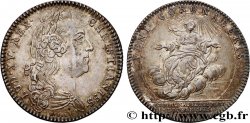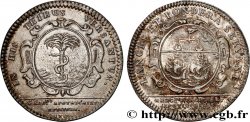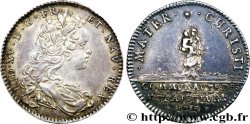Obverse
Obverse legend : LA VILLE. DE. PARIS : À L’EXERGUE 1699.
Obverse description : Vu de Paris depuis la Seine.
Reverse
Reverse legend : UT. COETERAS. DIRIGAT ; À L'EXERGUE : LE PREMIER. CORPS. DES. MARCHANDS. DE. PARIS.
Reverse description : Le vaisseau du premier corps des marchands allant à droite, un œil en haut du mat central.
Reverse translation : POUR DIRIGER LES AUTRES.
Historical background
CORPORATIONS
In Rome, groups of artisans already existed: forming a college placed under the protection of a divinity, with a common house and fund. In medieval Europe, probably from religious brotherhoods, economic groups were formed between merchants called hanse or ghilde.. With the development of trade, craftsmen organized themselves into trade bodies or communities which brought together all those who practiced the same profession: masters, journeymen or apprentices.. To enter the body, you had to "swear" the profession. Alongside, there were free professions that could be practiced by all.. Each corps was headed by a collegial management responsible for enforcing the regulations of the trade, protecting the trade from competition and directing the mutual benefit society.. At the end of the 17th century, the king began to sell the functions of jurors and corporate trustees as hereditary offices, which led to serious financial difficulties at a time when the corporations no longer met the new economic requirements of the development of industry and business concentration. It is also in England that the corporations disappeared spontaneously because of the industrial revolution.. The corporations will be abolished in France in 1791 by the Constituent Assembly.










 Report a mistake
Report a mistake Print the page
Print the page Share my selection
Share my selection Ask a question
Ask a question Consign / sell
Consign / sell
 Full data
Full data









